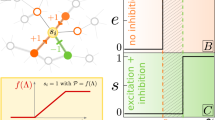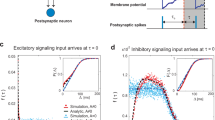Abstract
Asynchronous activity in balanced networks of excitatory and inhibitory neurons is believed to constitute the primary medium for the propagation and transformation of information in the neocortex. Here we show that an unstructured, sparsely connected network of model spiking neurons can display two fundamentally different types of asynchronous activity that imply vastly different computational properties. For weak synaptic couplings, the network at rest is in the well-studied asynchronous state, in which individual neurons fire irregularly at constant rates. In this state, an external input leads to a highly redundant response of different neurons that favors information transmission but hinders more complex computations. For strong couplings, we find that the network at rest displays rich internal dynamics, in which the firing rates of individual neurons fluctuate strongly in time and across neurons. In this regime, the internal dynamics interact with incoming stimuli to provide a substrate for complex information processing and learning.
This is a preview of subscription content, access via your institution
Access options
Subscribe to this journal
Receive 12 print issues and online access
$209.00 per year
only $17.42 per issue
Buy this article
- Purchase on Springer Link
- Instant access to full article PDF
Prices may be subject to local taxes which are calculated during checkout





Similar content being viewed by others
References
Shadlen, M.N. & Newsome, W.T. Noise, neural codes and cortical organization. Curr. Opin. Neurobiol. 4, 569–579 (1994).
van Vreeswijk, C. & Sompolinsky, H. Chaos in neuronal networks with balanced excitatory and inhibitory activity. Science 274, 1724–1726 (1996).
Amit, D.J. & Brunel, N. Model of global spontaneous activity and local structured activity during delay periods in the cerebral cortex. Cereb. Cortex 7, 237–252 (1997).
Troyer, T.W. & Miller, K.D. Physiological gain leads to high ISI variability in a simple model of a cortical regular spiking cell. Neural Comput. 9, 971–983 (1997).
Shadlen, M.N. & Newsome, W.T. The variable discharge of cortical neurons: implications for connectivity, computation, and information coding. J. Neurosci. 18, 3870–3896 (1998).
Shu, Y., Hasenstaub, A. & McCormick, D.A. Turning on and off recurrent balanced cortical activity. Nature 423, 288–293 (2003).
London, M., Roth, A., Beeren, L., Häusser, M. & Latham, P.E. Sensitivity to perturbations in vivo implies high noise and suggests rate coding in cortex. Nature 466, 123–127 (2010).
Renart, A. et al. The asynchronous state in cortical circuits. Science 327, 587–590 (2010).
Brunel, N. Dynamics of sparsely connected networks of excitatory and inhibitory spiking neurons. J. Comput. Neurosci. 8, 183–208 (2000).
Monteforte, M. & Wolf, F. Dynamical entropy production in spiking neuron networks in the balanced state. Phys. Rev. Lett. 105, 268104 (2010).
Monteforte, M. & Wolf, F. Dynamic flux tubes form reservoirs of stability in neuronal circuits. Phys. Rev. X 2, 041007 (2012).
Brunel, N. & Wang, X.-J. Effects of neuromodulation in a cortical network model of object working memory dominated by recurrent inhibition. J. Comput. Neurosci. 11, 63–85 (2001).
Wang, X.-J. Probabilistic decision making by slow reverberation in cortical circuits. Neuron 36, 955–968 (2002).
Dayan, P. & Abbott, L.F. Theoretical Neuroscience (MIT Press, 2001).
Sompolinsky, H., Crisanti, A. & Sommers, H. Chaos in random neural networks. Phys. Rev. Lett. 61, 259–262 (1988).
Jaeger, H. & Haas, H. Harnessing nonlinearity: predicting chaotic systems and saving energy in wireless communication. Science 304, 78–80 (2004).
Sussillo, D. & Abbott, L.F. Generating coherent patterns of activity from chaotic neural networks. Neuron 63, 544–557 (2009).
Toyoizumi, T. & Abbott, L.F. Beyond the edge of chaos: amplification and temporal integration by recurrent networks in the chaotic regime. Phys. Rev. E 84, 051908 (2011).
Laje, R. & Buonomano, D.V. Robust timing and motor patterns by taming chaos in recurrent neural networks. Nat. Neurosci. 16, 925–933 (2013).
Buonomano, D.V. & Maass, W. State-dependent computations: spatiotemporal processing in cortical networks. Nat. Rev. Neurosci. 10, 113–125 (2009).
Wainrib, G. & Touboul, J. Topological and dynamical complexity of random neural networks. Phys. Rev. Lett. 110, 118101 (2013).
Sussillo, D. & Barak, O. Opening the black box: low-dimensional dynamics in high-dimensional recurrent neural networks. Neural Comput. 25, 626–649 (2013).
Wallace, E., Maei, H.R. & Latham, P.E.L. Randomly connected networks have short temporal memory. Neural Comput. 25, 1408–1439 (2013).
Churchland, M.M. & Abbott, L.F. Two layers of neural variability. Nat. Neurosci. 15, 1472–1474 (2012).
Brunel, N. & Hakim, V. Fast global oscillations in networks of integrate-and-fire neurons with low firing rates. Neural Comput. 11, 1621–1671 (1999).
Amit, D.J. & Tsodyks, M.V. Quantitative study of attractor neural network retrieving at low spike rates. 1. Substrate spikes, rates and neuronal gain. Network 2, 259–273 (1991).
Rajan, K. & Abbott, L.F. Eigenvalue spectra of random matrices for neural networks. Phys. Rev. Lett. 97, 188104 (2006).
Timme, M., Wolf, F. & Geisel, T. Topological speed limits to network synchronization. Phys. Rev. Lett. 92, 074101 (2004).
Ostojic, S. & Brunel, N. From spiking neuron models to linear-nonlinear models. PLoS Comput. Biol. 7, e1001056 (2011).
Schaffer, E.S., Ostojic, S. & Abbott, L.F.A. Complex-valued firing-rate model that approximates the dynamics of spiking networks. PLoS Comput. Biol. 9, e1003301 (2013).
Rajan, K., Abbott, L.F. & Sompolinsky, H. Stimulus-dependent suppression of chaos in recurrent neural networks. Phys. Rev. E 82, 011903 (2010).
Churchland, M.M., Yu, B.M., Sahani, M. & Shenoy, K.V. Techniques for extracting single-trial activity patterns from large-scale neural recordings. Curr. Opin. Neurobiol. 17, 609–618 (2007).
Rabinovich, M., Huerta, R. & Laurent, G. Neuroscience. Transient dynamics for neural processing. Science 321, 48–50 (2008).
Rigotti, M., Rubin, D.B.D., Wang, X.-J. & Fusi, S. Internal representation of task rules by recurrent dynamics: the importance of the diversity of neural responses. Front. Comput. Neurosci. 4, 24 (2010).
Rigotti, M. et al. The importance of mixed selectivity in complex cognitive tasks. Nature 497, 585–590 (2013).
Mazor, O. & Laurent, G. Transient dynamics versus fixed points in odor representations by locust antennal lobe projection neurons. Neuron 48, 661–673 (2005).
Churchland, M.M., Cunningham, J.P., Kaufman, M.T., Ryu, S.I. & Shenoy, K.V. Cortical preparatory activity: representation of movement or first cog in a dynamical machine? Neuron 68, 387–400 (2010).
Churchland, M.M. et al. Stimulus onset quenches neural variability: a widespread cortical phenomenon. Nat. Neurosci. 13, 369–378 (2010).
Ginzburg, I. & Sompolinsky, H. Theory of correlations in stochastic neural networks. Phys. Rev. E Stat. Phys. Plasmas Fluids Relat. Interdiscip. Topics 50, 3171–3191 (1994).
Gerstner, W. Time structure of the activity in neural network models. Phys. Rev. E Stat. Phys. Plasmas Fluids Relat. Interdiscip. Topics 51, 738–758 (1995).
Gerstner, W. Population dynamics of spiking neurons: fast transients, asynchronous states, and locking. Neural Comput. 12, 43–89 (2000).
Wong, K.F. & Wang, X.-J. A recurrent network mechanism of time integration in perceptual decisions. J. Neurosci. 26, 1314–1328 (2006).
Rangan, A.V. & Young, L.S. Emergent dynamics in a model of visual cortex. J. Comput. Neurosci. 35, 155–167 (2013).
Litwin-Kumar, A. & Doiron, B. Slow dynamics and high variability in balanced cortical networks with clustered connections. Nat. Neurosci. 15, 1498–1505 (2012).
Tetzlaff, T., Helias, M., Einevoll, G.T. & Diesmann, M. Decorrelation of neural-network activity by inhibitory feedback. PLoS Comp. Biol. 8, e1002596 (2012).
Roxin, A., Brunel, N., Hansel, D., Mongillo, G. & van Vreeswijk, C. On the distribution of firing rates in networks of cortical neurons. J. Neurosci. 31, 16217–16226 (2011).
Helias, M., Deger, M., Rotter, S. & Diesmann, M. Instantaneous non-linear processing by pulse-coupled threshold units. PLoS Comp. Biol. 6, e1000929 (2010).
Ostojic, S. Interspike interval distributions of spiking neurons driven by fluctuating inputs. J. Neurophysiol. 106, 361–373 (2011).
Rajan, K., Abbott, L.F. & Sompolinsky, H. Inferring stimulus selectivity from the spatial structure of neural network dynamics. in Advances in Neural Information Processing Systems 23 (eds. Lafferty, J., Williams, C.K.I., Shawe-Taylor, J., Zemel, R. & Culotta A.) 1975–1983 (Curran, 2010).
Acknowledgements
The author is grateful to N. Brunel, V. Hakim, D. Martí and M. Stern for discussions and feedback on the manuscript. This work was supported by France's Agence Nationale de la Recherche ANR-11-0001-02 PSL* and ANR-10-LABX-0087.
Author information
Authors and Affiliations
Corresponding author
Ethics declarations
Competing interests
The author declares no competing financial interests.
Rights and permissions
About this article
Cite this article
Ostojic, S. Two types of asynchronous activity in networks of excitatory and inhibitory spiking neurons. Nat Neurosci 17, 594–600 (2014). https://doi.org/10.1038/nn.3658
Received:
Accepted:
Published:
Issue Date:
DOI: https://doi.org/10.1038/nn.3658
This article is cited by
-
Fluctuation–response relations for integrate-and-fire models with an absolute refractory period
Biological Cybernetics (2024)
-
Embedded chimera states in recurrent neural networks
Communications Physics (2022)
-
Brain information processing capacity modeling
Scientific Reports (2022)
-
How to wake up the electric synapse coupling between neurons?
Nonlinear Dynamics (2022)
-
Large coefficient of variation of inter-spike intervals induced by noise current in the resonate-and-fire model neuron
Cognitive Neurodynamics (2022)



